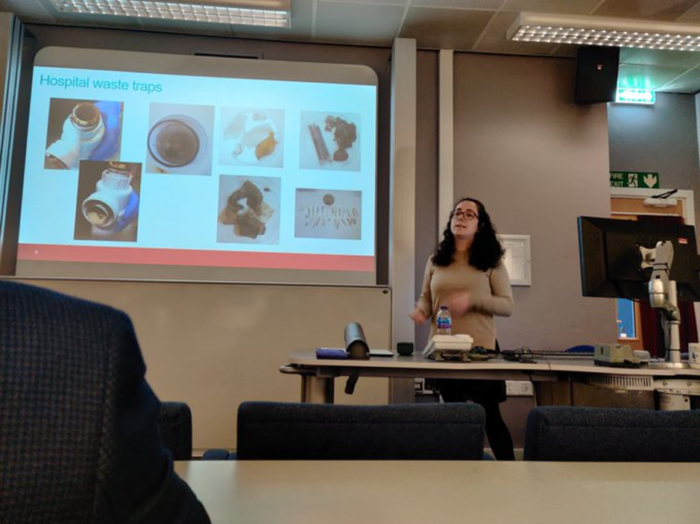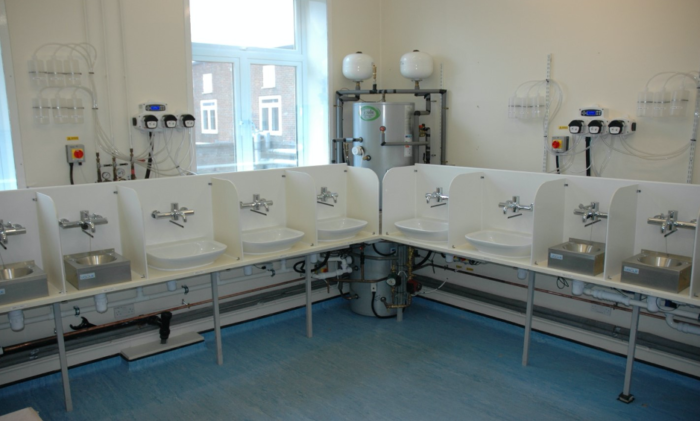Jam Talks: Waste water, CPE and sinks, oh my!
Posted on March 16, 2020 by Paz Aranega Bou
The Junior Awards for Microbiology (JAM) Talks is a monthly seminar series based in Birmingham that allows early career researchers to gain experience presenting to an audience of their peers. Dr Paz Aranega Bou, a water systems microbiologist at Public Health England (PHE), presented her work at the November JAM Talks in 2019. Here Paz takes us through her research.
Last November I had the opportunity to present my current research at the University of Birmingham, as part of the JAM seminar series 2019/2020. The atmosphere was relaxed and friendly and presenting to a room full of early career microbiologists meant that questions were genuine and interesting. I thoroughly enjoyed presenting and the discussions that followed, and felt very welcomed.

In my talk I summarised my current research work. I joined Public Health England in 2017 as a water systems microbiologist. Since then, my world has spun around sinks!
At PHE, I work in the Biosafety, Air and Water Microbiology Group. The group uses expertise in environmental microbiology to assess interventions to prevent transmission of infections in healthcare and other settings. In our group it is quite common that projects arise from the gaps in understanding after an outbreak investigation, and that’s exactly how we got involved with sinks!
Sink waste traps and drains are commonly colonised with members of the Enterobacterales order (Klebsiella spp., Enterobacter spp. etc.), Pseudomonas spp. and other Gram-negative opportunistic pathogens. In hospitals, these bacteria are often resistant to antibiotics, and of particular concern are those that are resistant to carbapenems, which are often referred to as ‘antibiotics of last resort’. Carbapenemase-producing Enterobacterales (CPE) produce enzymes that break-down carbapenems, destroying these and other antibiotics, making infections difficult to treat. Moreover, the genes that encode for carbapenemases are often located on mobile genetic elements that can be exchanged between strains (the nightmare of any epidemiologist!). Unfortunately, CPE are becoming increasingly common causes of healthcare-associated infections worldwide, including in the UK.
During a CPE outbreak, colonised patients are believed to be the main reservoir of CPE with transmission to other patients occurring through direct or indirect contact. Good hand hygiene by staff, patients and visitors is key to breaking transmission. However, in some hospitals, the same or highly similar strains have been found in patients and sinks, raising questions regarding the potential role of sinks. Could sinks be a source of CPE infection?
To address this question (without interfering with the day-to-day running of a busy hospital) a model sink system was designed and built at PHE Porton Down. The model incorporates twelve sinks of two different designs: rear-draining hand-wash basins and base-draining utility sinks. Hospital waste traps were collected and installed within the model system and experiments began. Working with a large-scale model system can be challenging but allows you to test hypotheses in a realistic setting while being able to control variables much more easily than in the real world. We have had to deal with blockages, dripping taps and all sorts of plumbing issues, but all the effort has paid off. Our results, published in the Journal of Hospital Infection, showed that contaminated sinks can disperse CPE back into the environment, particularly when the tap is aligned to discharge directly into a contaminated drain and when drainage is slow. We also demonstrated that sink design can minimise or even prevent dispersal; for example, when draining efficiently, there was little to no dispersal from rear-draining clinical hand-wash basins. Studies using this model system have also shown that CPE can migrate through pipework and colonise new sinks. In our system, this was likely facilitated by a waste water backflow event and highlights once more the importance of ensuring good, efficient drainage.

Apart from working in the lab, I have also had the opportunity to venture into the real world and carry out environmental sampling in different hospitals. The results from a small pilot study have suggested that CPE might be common contaminants in sinks, highlighting the importance of fully understanding the potential risks associated with this reservoir.
I am now focusing my efforts on understanding which parameters determine which parts of the sink become contaminated and evaluating interventions to prevent dispersal from sinks. Wish me luck!
Reference for publication: Aranega-Bou P, George RP, Verlander NQ, Paton S, Bennett A et al. Carbapenem-resistant Enterobacteriaceae dispersal from sinks is linked to drain position and drainage rates in a laboratory model system. J Hosp Infect 2019;102:63–69. DOI: 10.1016/j.jhin.2018.12.007.

